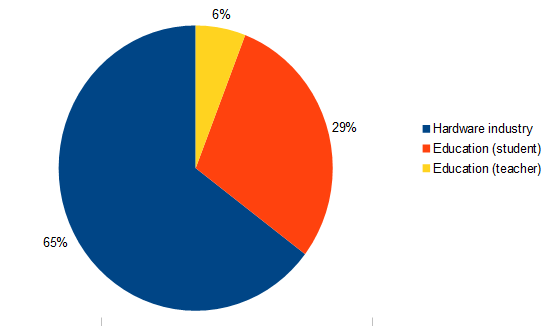Future posts, tailored for You!
For some time, I’ve been running a survey for electrical engineers, about the problems faced by people on this awesome field. The reason behind is simple: I want to write stuff that gets read, and also is useful people. What people need to read and will read, that is.
Well, the rate of responses has now dropped sharply, so it’s time for a wrap-up.
So here you have it: results from the Electromechanics Survey.
Demographics
A huge majority of the survey respondents (almost 70 %) worked in the hardware industry. The remainder consisted almost solely of academia: students and teachers. No one worked in the software industry, and the Other category only got a few stray replies. That included two bloggers by the way, one of them yours trule.
Roughly 73 % of the hardware people worked in product development, while the rest were at sales or miscellaneous duties.
Problems
The final, and one could say most important, question of the survey was open-ended: what’s causing you trouble. Needless to say, there were as many different responses as there were respondents. Nonetheless, three common themes could be identified.
1) Uncertainty
The first one was uncertainty related to the measurements, materials, and simulations. Examples included having to deal with uncertain material parameters. Insulation materials and structures were mentioned several times. Also arcing simulations were brought up, as the phenomenon is fundamentally stochastic.
2) Interpersonal relationships
Working and communicating with others also caused many respondents trouble. Especially issues with the management were widely reported.
Things such as networking and knowledge transfer were also brought up.
3) Resistive AC losses
This is heartwarming, to be working on something that actually matters to someone.
Solutions
So, based on these responses I’ve made some decisions about what to write about in the future.
Posts about stochastics
Luckily, I began my research career with uncertainty quantification and stochastic finite elements, so I will definitely write a post or ten about them in the near future. So, expect to be reading pieces about polynomial chaos and intrusive/non-intrusive stochastic models. And you have already seen some of my work about random-wound machines, haven’t you?
Admittedly, insulation design is something I’m not entirely familiar with. But, that simply means I’ve got another new thing to study – how awesome is that? But the concept of uncertainty is definitely not limited to them – simply check out this post about mechanical engineering for an example.
Indeed, this topic has gathered huge amounts of interest in the recent years. Designing a machine is one thing. Analysing its lifetime reliability is wholly another.
Furthermore, the overall trend seems to be moving from single design simulations to large sets with slightly perturbed parameters. Just to estimate the expected variations in the final products. Makes it even more important to be able to do the simulations fast, doesn’t it?
Posts about communication
Dealing with people has never been my strong suite. But, this simply means I can easily identify with others facing the same problem. Furthermore, I can determine what actually works and what doesn’t, since I have actually had to pay some conscious attention on the issue. By contrast, I definitely couldn’t teach you the Finnish grammar – I’ve speaking Finnish all my life, and the process is fully automatic for me. Just an example of what I mean.
Anyway, expect a few thousand words about communication and relationships, too.
Knowledge transfer is more difficult, though. It can mean passing on expertise from retiring experts to new recruits, or between professionals alike. In any case, it takes a lot of time. A blog post really cannot do the process for you. If you have any ideas about what might help, let me know!
Business as usual
The third problem revealed by the survey – AC losses – luckily is easy for me to solve. That’s what I have been doing already – writing posts about my research. I will definitely continue doing so in the future, too.
I might also write some tutorial-esque pieces too.
Oh and by the way, my SMEKlib FEM library for Matlab is now available OpenSource! Just the basic functionality for now, but I will definitely add my loss models in the future.

Conclusion
So that’s a wrap for now, folks. The survey form is still open, so you are free to add your contribution if you haven’t done so already. Or, you can simply write a comment below.
Best,
-Antti
Check out EMDtool - Electric Motor Design toolbox for Matlab.
Need help with electric motor design or design software? Let's get in touch - satisfaction guaranteed!


I am very curious about what you call “uncertainty quantification” and “stochastic finite elements”… never heard about that before… It would be nice to have some light on those seemingly complex (but also fascinating) expressions 😉
Thanks for the great question! We know that there is some uncertainty in the entire computer-aided-design process; the reality never perfectly matches the simulations, and no two product specimens are exactly equal.
Uncertainty quantification (UQ) means assigning some numbers to this uncertainty: how do the material parameters vary, and what kind of variation does this cause in the characteristics of the final product. Obviously, this is very multi-faceted problem, and requires both measuring and analysing the input data, and quite involved simulations and processing the results.
Stochastic finite element analysis (sFEM) is a part of the UQ process. We have quantified the uncertainties in the materials, production techniques, geometry, etc., and now its time to predict how much and how these influence the end result. We can either do many simulations with different data (non-intrusive approach), or we can modify our FEA codes to directly include the uncertainty in a single simulation (intrusive approach). Both require their special tricks, and have been quite intensely studied in the last decade or so.
Hope this answered your question 😀